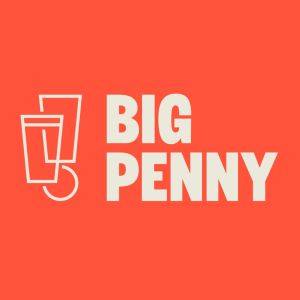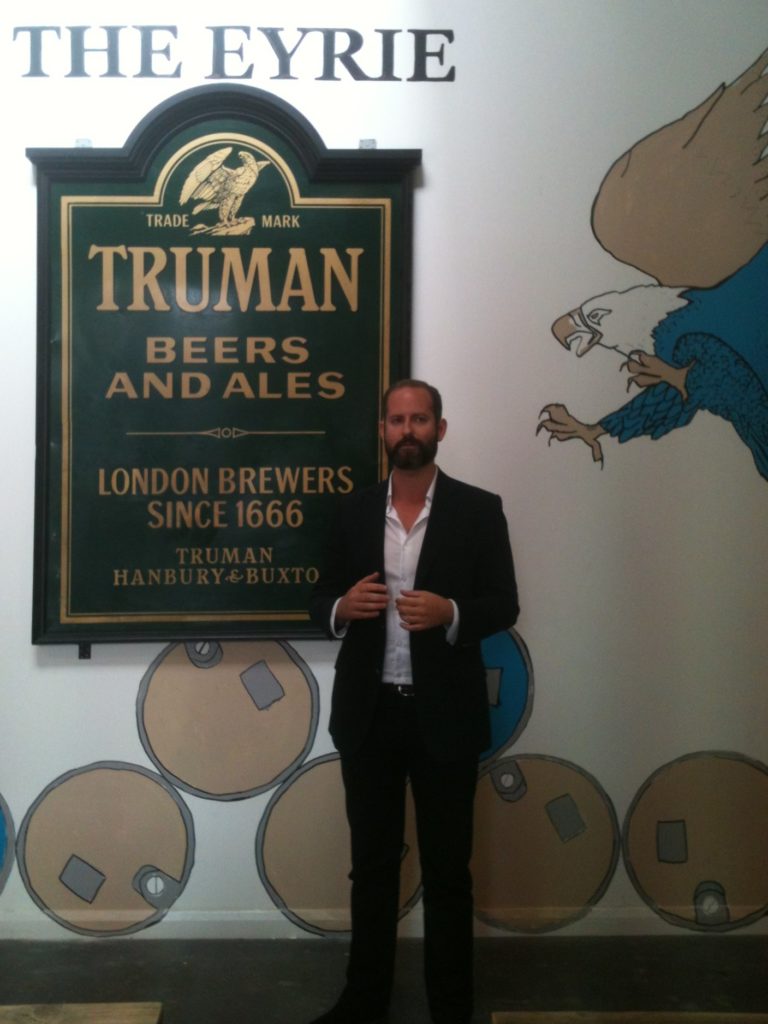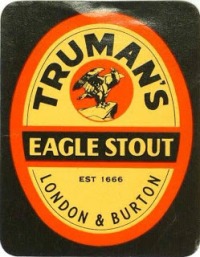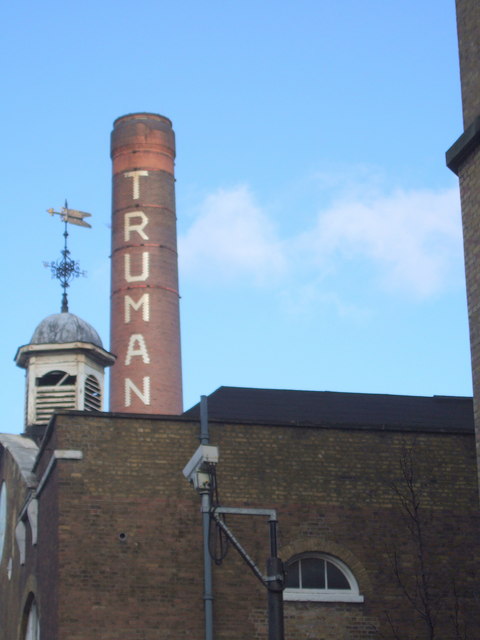Previously Truman’s Beer.

Includes information about the original Truman brewery.
Beer firm, suspended brewery
Original site: 2 Stour Road E3 2NT (Tower Hamlets)
Second site: The Brew Shed, 14A Queens Yard E9 5EN (Tower Hamlets)
Taproom, possible future site: 1 Priestley Way E17 6AL (Waltham Forest)
bigpenny.co.uk
First sold beer: July 2013 (as Truman’s Beer at original site)
Brewing suspended: May 2022
Truman, Hanbury & Buxton (Truman Brewery, latterly Watney Mann Truman)
Closed brewery
Black Eagle Brewery, Hanbury Street E1 6QR (Tower Hamlets)
First sold beer: 1666 (as Bucknall’s)
Ceased brewing: 1989
As explained below, Truman’s, based at the Black Eagle brewery in Brick Lane until its closure in 1989, is one of the most important names in London brewing history. That history fascinated James Morgan and Michael-George Hemus, who worked as young professionals around the site in the early 2000s, and in an inspired moment they decided to revive the brand. The trademark had been inherited by Heineken, who were eventually persuaded first to license it then to sell it.

In June 2010, a new beer, Truman’s Runner, based on the spirit but not the letter of the old, appeared in London pubs. At first this was cuckoo brewed outside London, initially at Nethergate in Clare, Suffolk and from October 2011 at Everards in Leicester, but always with the intention of bringing brewing back to the capital.
The historic site sadly proved impractical and unaffordable, but in July 2013 Truman’s began brewing at Fish Island in Hackney Wick using a new 33 hl brewhouse and the original Truman yeast strain, a sample of which had been deposited at the National Collection of Yeast Cultures in 1958. The original head brewer was German-born Ben Ott, formerly at London Fields and later a co-founder at 40FT. In 2015, the brewery, known as the Eyrie, expanded to a neighbouring unit previously occupied by Beavertown, with increased fermentation capacity and a new kegging line.
With production reaching 17,000 hl per year by 2019, no space for further expansion and the site under threat of redevelopment, the brewery secured much bigger premises in the growing brewing centre of Blackhorse Lane in western Walthamstow. The original intention was to install an 80 hl German-style brewhouse, a 10 hl pilot kit and a large and comfortable taproom with performance space, aiming for an annual output to 150,000 hl.
These plans were seriously disrupted by the Covid-19 lockdown in 2020, and the brewery found itself unable to install a brewery at the new site before it was forced out of its Fish Island home, which was subsequently demolished. Coincidentally, Crate brewery, not far away in Queens Yard, got into difficulties at the same time, and Truman’s took over its production brewhouse from July 2020. Though the 16 hl kit here had substantially less capacity than Truman’s previous equipment, this interim arrangement provided a way out of difficult circumstances.
Truman’s still had the lease on the Blackhorse Lane site and, following the easing of the first lockdown, opened it in July 2020 as a bar and events space known as Truman’s Social Club, taking advantage of the vast size to create a purpose-designed socially distanced venue. The intention remained to relocate brewing here eventually. During this period James moved on and Michael-George, who had stepped back from the business, returned to run it.
Unfortunately this didn’t resolve the difficulties as the Queens Yard site had to close in May 2022 due to redevelopment, but still with no capacity to relocate production to Blackhorse Lane. The company shifted to contract brewing, I believe at Redchurch in Essex.
To raise further funds, the company sold the Truman brand in September 2022 and rebranded to Big Penny, acknowledging a former copper mill close to the Blackhorse site which supplied materials for penny coins. The Truman name now belongs to the owners of the Old Truman Brewery in Brick Lane, who may possibly commission their own beers using it.
The main venue is now known as the Big Penny Social, and the intention remains to brew there at some point in the future.
The company also owns a West End pub, the Newman Arms in Fitzrovia, taken over in 2018 though up for sale in 2022, and an airside bar at London City Airport, originally known as Brick Lane Brews but since rebranded to Big Penny Brews.
Beers were in cask, tank, keg and can. Cask was the mainstay in the early years, and despite the difficulties of Covid, Truman’s continued with the format, though at reduced volumes, droppng it with the shift to contract brewing. Previously, Truman’s also brewed for others, notably assisting in the return of London Fields beers to London.
London’s first Truman’s brewery

Brick Lane was little more than a country track through open fields back in the mid-17th century when Thomas Bucknall chose Lotsworth Field, towards the Shoreditch end, as the location of his small Black Eagle brewery. Sometime in the 1660s one Joseph Truman was put on the payroll, and by 1697 Truman had bought Bucknall out. Truman’s shrewd and ambitious grandson Benjamin joined the board in 1722, and began the process of turning the brewery into one of London’s biggest and most successful by concentrating on porter brewing.
By the 1830s, Truman Hanbury & Buxton, as it was now known, was producing 330,000 hl of porter a year, and its Black Eagle trademark was known throughout the country. The brewery’s philanthropic links are mentioned by Charles Dickens in David Copperfield: Thomas Buxton was an anti-slavery campaigner and prison reformer who joined the board in 1809. He and his uncle and fellow partner, the tobacco importer Sampson Hanbury, were Quakers, related to the Barclays who part-owned Barclay Perkins.

Like several other London brewers, Truman set up a second home in Burton upon Trent when pale ales came into fashion and from the 1870s brewing in London declined, though the Brick Lane site remained important. It was rebuilt extensively in 1929, with a new boiler house sprouting a 49 m-high brick chimney that still dominates the local roofscape. It emerged relatively unscathed from World War II and clung doggedly to its independence as consolidation swept the industry in the 1950s and 1960s.
Finally in 1971 it fell to the Grand Metropolitan hotel group who used it as leverage to buy out Watney the following year, creating Watney Mann Truman. At this stage it was still brewing a cask mild and a well-regarded Export Draught Bitter for sale through its 1,100 pubs in Greater London and surroundings. But by the mid-1970s it had switched to keg and bottled beer only.

Grand Met later withdrew from brewing and closed the Black Eagle in 1988 after years of neglect. By the end of the 1990s the site had been repurposed as an arts, business, shopping and leisure complex, rapidly becoming the centre of gravity of an increasingly trendy local scene and providing yet another new face to what had already become one of London’s most frequently reinvented streets.
In September 2021, Tower Hamlets council approved a major mixed use redevelopment proposal for the site, amid fierce controversy due to local fears about its impact on independent traders and an erosion of the lively street scene. Currently, most of the old brewery fabric remains, retaining the impression of its size, sprawling across both sides of Brick Lane. Though the most notable historic buildings are listed and will have to be preserved in any redevelopment, the more modern structures are likely to be demolished and replaced, which will inevitably change the character of the site.
Updated 5 May 2023.





Leave a Reply